Ethanolic Extract of Ocimum sanctum Linn. Inhibits Cell Migration of Human Lung Adenocarcinoma Cells (A549) by Downregulation of Integrin αvβ3, α5β1, and VEGF
Abstract
1. Introduction
2. Materials and Methods
2.1. Preparation of Ocimum sanctum Linn. Ethanolic Extract (EEOS)
2.2. Cell Maintenance
2.3. Adhesion Assay Using Cell Counting Kit-8 Assay
2.4. A549 Cell Lysate Preparation
2.5. Enzyme-Linked Immunosorbent Assay (ELISA)
2.5.1. Integrin Human ITG αvβ3 dan VEGF
2.5.2. Integrin Human ITG α5β1
2.5.3. Enzyme-Linked Immunosorbent Assay (ELISA) Data Analysis
2.6. Scratch Wound Healing Assay
3. Results
3.1. EEOS Inhibited the Adhesion of A549 (Non-Small Cell Lung Carcinoma)
3.2. EEOS Inhibited the Cell Migration of A549 (Non-Small Cell Lung Carcinoma) after 24 h of Treatment
3.3. EEOS Inhibited Cell Migration of the A549 Cell Line (Non-Small Cell Line Carcinoma) by Suppressing the Concentrations of Integrin αvβ3, Integrin α5β1, and Vascular Endothelial Growth Factor (VEGF)
4. Discussion
5. Conclusions
Author Contributions
Funding
Institutional Review Board Statement
Informed Consent Statement
Data Availability Statement
Acknowledgments
Conflicts of Interest
References
- Wulandari, L.; Febriani, A.; Fatmawati, F.; Soegiarto, G. Evaluation of Patients with Lung Cancer Treated with Epidermal Growth Factor Receptor–Tyrosine Kinase Inhibitor. Asian J. Oncol. 2018, 4, 48–53. [Google Scholar] [CrossRef]
- Saba, N.; Khuri, F. The Role of Bisphosphonates in the Management of Advanced Cancer with a Focus on Non-Small-Cell Lung Cancer—Part I: Mechanisms of Action, Role of Biomarkers and Preclinical Applications. Oncology 2005, 68, 10–17. [Google Scholar] [CrossRef] [PubMed]
- Hellmann, M.D.; Paz-Ares, L.; Bernabe Caro, R.; Zurawski, B.; Kim, S.-W.; Carcereny Costa, E.; Park, K.; Alexandru, A.; Lupinacci, L.; de la Mora Jimenez, E.; et al. Nivolumab plus Ipilimumab in Advanced Non–Small-Cell Lung Cancer. N. Engl. J. Med. 2019, 381, 2020–2031. [Google Scholar] [CrossRef]
- Park, J.; Jeong, D.; Song, M.; Kim, B. Antioxidants Recent Advances in Anti-Metastatic Approaches of Herbal Medicines in 5 Major Cancers: From Traditional Medicine to Modern Drug Discovery. Antioxidants 2021, 10, 527. [Google Scholar] [CrossRef] [PubMed]
- Garcia-Oliveira, P.; Fraga-Corral, M.; Pereira, A.G.; Lourenço-Lopes, C.; Jimenez-Lopez, C.; Prieto, M.A.; Simal-Gandara, J. Scientific Basis for the Industrialization of Traditionally Used Plants of the Rosaceae Family. Food Chem. 2020, 330, 127197. [Google Scholar] [CrossRef]
- Redondo-Blanco, S.; Fernández, J.; Gutiérrez-del-Río, I.; Villar, C.J.; Lombó, F. New Insights toward Colorectal Cancer Chemotherapy Using Natural Bioactive Compounds. Front. Pharmacol. 2017, 8, 109. [Google Scholar] [CrossRef]
- Magesh, V.; Lee, J.-C.; Ahn, K.S.; Lee, H.-J.; Lee, H.-J.; Lee, E.-O.; Jung, H.J.; Kim, J.S.; Kim, D.K.; Choi, S.-H.; et al. Ocimum sanctum Induces Apoptosis in A549 Lung Cancer Cells and Suppresses the In Vivo Growth of Lewis Lung Carcinoma Cells. Phytother. Res. 2009, 23, 1385–1391. [Google Scholar] [CrossRef]
- Wihadmadyatami, H.; Karnati, S.; Hening, P.; Tjahjono, Y.; Rizal; Maharjanti, F.; Kusindarta, D.L.; Triyono, T.; Supriatno. Ethanolic Extract Ocimum sanctum Linn. Induces an Apoptosis in Human Lung Adenocarcinoma (A549) Cells. Heliyon 2019, 5, e02772. [Google Scholar] [CrossRef]
- Wihadmadyatami, H.; Hening, P.; Kustiati, U.; Kusindarta, D.L.; Triyono, T.; Supriatno, S. Ocimum sanctum Linn. Ethanolic Extract Inhibits Angiogenesis in Human Lung Adenocarcinoma (A549) Cells. Vet. World 2020, 13, 2028–2032. [Google Scholar] [CrossRef]
- Kim, S.C.; Magesh, V.; Jeong, S.J.; Lee, H.J.; Ahn, K.S.; Lee, H.J.; Lee, E.O.; Kim, S.H.; Lee, M.H.; Kim, J.H.; et al. Ethanol Extract of Ocimum sanctum Exerts Anti-Metastatic Activity through Inactivation of Matrix Metalloproteinase-9 and Enhancement of Anti-Oxidant Enzymes. Food Chem. Toxicol. 2010, 48, 1478–1482. [Google Scholar] [CrossRef]
- Martinotti, S.; Ranzato, E. Scratch Wound Healing Assay. In Methods in Molecular Biology; Humana Press: Totowa, NJ, USA, 2020; Volume 2109, pp. 225–229. [Google Scholar]
- Hanahan, D. Hallmarks of Cancer: New Dimensions. Cancer Discov. 2022, 12, 31–46. [Google Scholar] [CrossRef] [PubMed]
- Abduljauwad, S.N.; Ahmed, H.u.R. Enhancing Cancer Cell Adhesion with Clay Nanoparticles for Countering Metastasis. Sci. Rep. 2019, 9, 5935. [Google Scholar] [CrossRef] [PubMed]
- Janiszewska, M.; Primi, M.C.; Izard, T. Cell Adhesion in Cancer: Beyond the Migration of Single Cells. J. Biol. Chem. 2020, 295, 2495–2505. [Google Scholar] [CrossRef] [PubMed]
- Pijuan, J.; Barceló, C.; Moreno, D.F.; Maiques, O.; Sisó, P.; Marti, R.M.; Macià, A.; Panosa, A. In Vitro Cell Migration, Invasion, and Adhesion Assays: From Cell Imaging to Data Analysis. Front. Cell Dev. Biol. 2019, 7, 107. [Google Scholar] [CrossRef]
- Xu, L.; Gordon, R.; Farmer, R.; Pattanayak, A.; Binkowski, A.; Huang, X.; Avram, M.; Krishna, S.; Voll, E.; Pavese, J.; et al. Precision Therapeutic Targeting of Human Cancer Cell Motility. Nat. Commun. 2018, 9, 2454. [Google Scholar] [CrossRef]
- Campbell, K.; Rossi, F.; Adams, J.; Pitsidianaki, I.; Barriga, F.M.; Garcia-Gerique, L.; Batlle, E.; Casanova, J.; Casali, A. Collective Cell Migration and Metastases Induced by an Epithelial-to-Mesenchymal Transition in Drosophila Intestinal Tumors. Nat. Commun. 2019, 10, 2311. [Google Scholar] [CrossRef]
- Kustiati, U.; Wihadmadyatami, H.; Kusindarta, D.L. Dataset of Phytochemical and Secondary Metabolite Profiling of Holy Basil Leaf (Ocimum sanctum Linn) Ethanolic Extract Using Spectrophotometry, Thin Layer Chromatography, Fourier Transform Infrared Spectroscopy, and Nuclear Magnetic Resonance. Data Brief 2022, 40, 107774. [Google Scholar] [CrossRef]
- Abotaleb, M.; Samuel, S.M.; Varghese, E.; Varghese, S.; Kubatka, P.; Liskova, A.; Büsselberg, D. Flavonoids in Cancer and Apoptosis. Cancers 2019, 11, 28. [Google Scholar] [CrossRef]
- Kustiati, U.; Dewi Ratih, T.S.; Dwi Aris Agung, N.; Kusindarta, D.L.; Wihadmadyatami, H. In Silico Molecular Docking and in Vitro Analysis of Ethanolic Extract Ocimum sanctum Linn.: Inhibitory and Apoptotic Effects against Non-Small Cell Lung Cancer. Vet. World 2021, 14, 3175–3187. [Google Scholar] [CrossRef]
- Kadry, Y.A.; Calderwood, D.A. Chapter 22: Structural and Signaling Functions of Integrins. Biochim. Biophys. Acta Biomembr. 2020, 1862, 183206. [Google Scholar] [CrossRef]
- Bachmann, M.; Kukkurainen, S.; Hytönen, V.P.; Wehrle-Haller, B. Cell adhesion by integrins. Physiol. Rev. 2019, 99, 1655–1699. [Google Scholar] [CrossRef] [PubMed]
- de Pascalis, C.; Etienne-Manneville, S. Single and Collective Cell Migration: The Mechanics of Adhesions. Mol. Biol. Cell 2017, 28, 1833–1846. [Google Scholar] [CrossRef] [PubMed]
- Sökeland, G.; Schumacher, U. The Functional Role of Integrins during Intra- and Extravasation within the Metastatic Cascade. Mol. Cancer 2019, 18, 12. [Google Scholar] [CrossRef]
- Weis, S.M.; Cheresh, D.A. Av Integrins in Angiogenesis and Cancer. Cold Spring Harb. Perspect. Med. 2011, 1, a006478. [Google Scholar] [CrossRef]
- Zhu, H.; Chen, A.; Li, S.; Tao, X.; Sheng, B.; Chetry, M.; Zhu, X. Predictive Role of Galectin-1 and Integrin A5β1 in Cisplatin-Based Neoadjuvant Chemotherapy of Bulky Squamous Cervical Cancer. Biosci. Rep. 2017, 37, BSR20170958. [Google Scholar] [CrossRef] [PubMed]
- Harjunpää, H.; Asens, M.L.; Guenther, C.; Fagerholm, S.C. Cell Adhesion Molecules and Their Roles and Regulation in the Immune and Tumor Microenvironment. Front. Immunol. 2019, 10, 1078. [Google Scholar] [CrossRef]
- Valdembri, D.; Serini, G. The Roles of Integrins in Cancer. Fac. Rev. 2021, 10, 45. [Google Scholar] [CrossRef]
- Zhang, J.; Liu, J.; Zhu, C.; He, J.; Chen, J.; Liang, Y.; Yang, F.; Wu, X.; Ma, X. Prognostic Role of Vascular Endothelial Growth Factor in Cervical Cancer: A Meta-Analysis. Oncotarget 2017, 8, 24797–24803. [Google Scholar] [CrossRef]
- Chen, Y.; Mathy, N.W.; Lu, H. The Role of VEGF in the Diagnosis and Treatment of Malignant Pleural Effusion in Patients with Non-Small Cell Lung Cancer (Review). Mol. Med. Rep. 2018, 17, 8019–8030. [Google Scholar] [CrossRef]
- Yang, Y.; Cao, Y. The Impact of VEGF on Cancer Metastasis and Systemic Disease. Semin. Cancer Biol. 2022, 86, 251–261. [Google Scholar] [CrossRef]
- Zhang, L.; Wang, J.N.; Tang, J.M.; Kong, X.; Yang, J.Y.; Zheng, F.; Guo, L.Y.; Huang, Y.Z.; Zhang, L.; Tian, L.; et al. VEGF Is Essential for the Growth and Migration of Human Hepatocellular Carcinoma Cells. Mol. Biol. Rep. 2012, 39, 5085–5093. [Google Scholar] [CrossRef] [PubMed]
- Lino, R.; Dos Santos, L.B.; Pisani, P.K.; Altei, G.F.D.; Cominetti, W.F.; Selistre-de-Araújo, H.S. Alphavbeta3 integrin blocking inhibits apoptosis and induces autophagy in murine breast tumor cells. Biochimica et Biophysica Acta (BBA)—Molecular Cell Research. Biochim. Biophys. Acta Mol. Cell Res. 2019, 12, 118536. [Google Scholar] [CrossRef] [PubMed]
- Goel, H.L.; Mercurio, A.M. VEGF targets the tumour cell. Nat. Rev. Cancer 2013, 12, 871–882. [Google Scholar] [CrossRef] [PubMed]
- Hou, J.; Yan, D.; Liu, Y.; Huang, P.; Cui, H. The Roles of Integrin α5β1 in Human Cancer. Onco Targets Ther. 2020, 13, 13329–13344. [Google Scholar] [CrossRef] [PubMed]
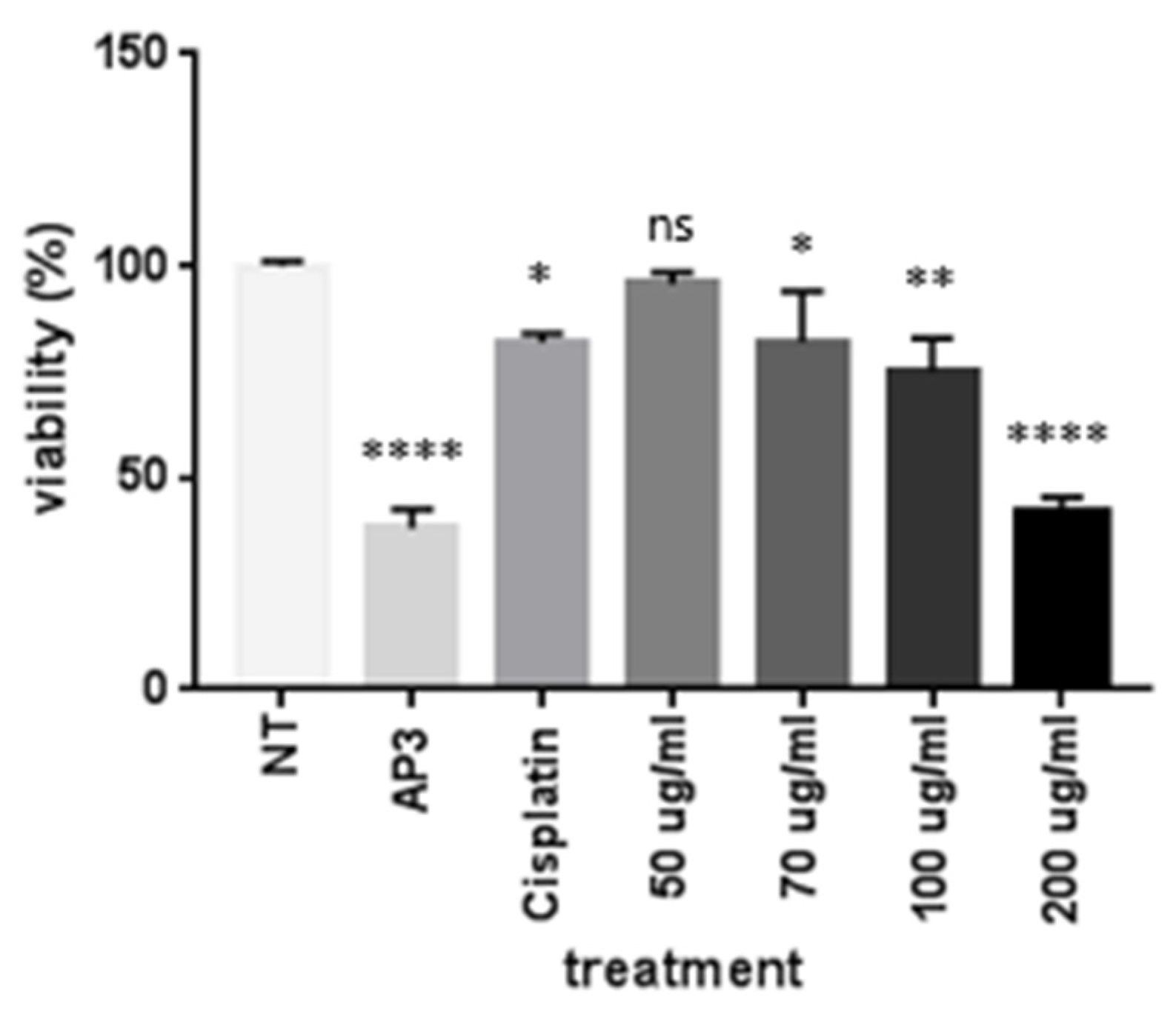
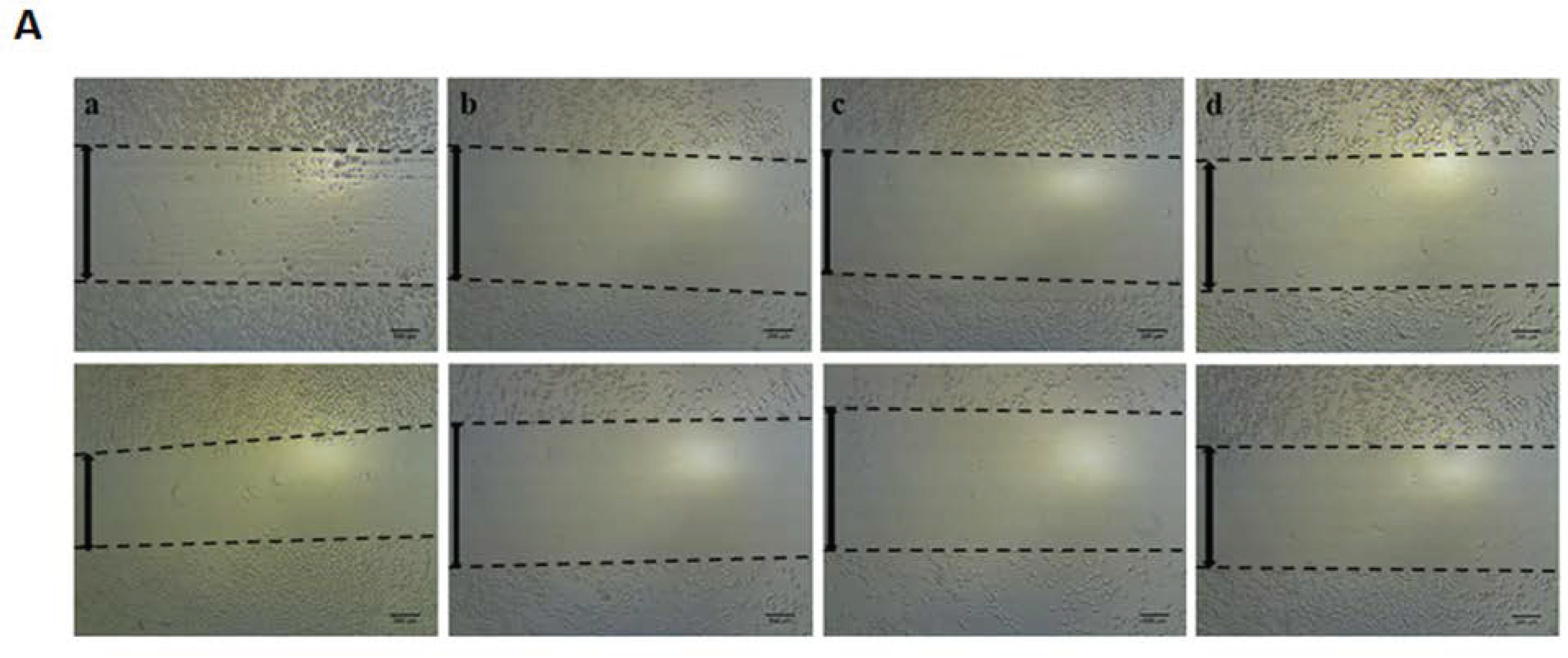
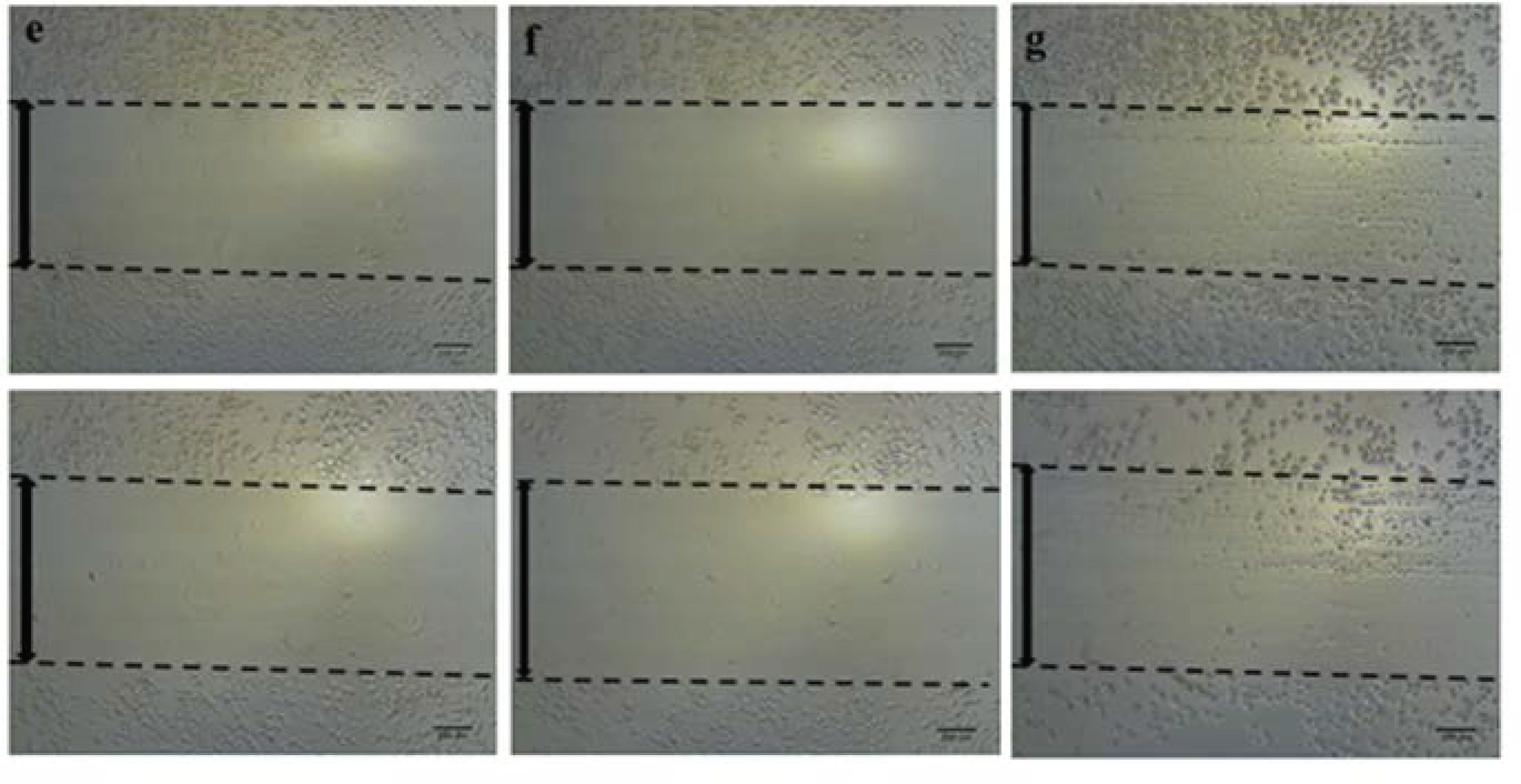
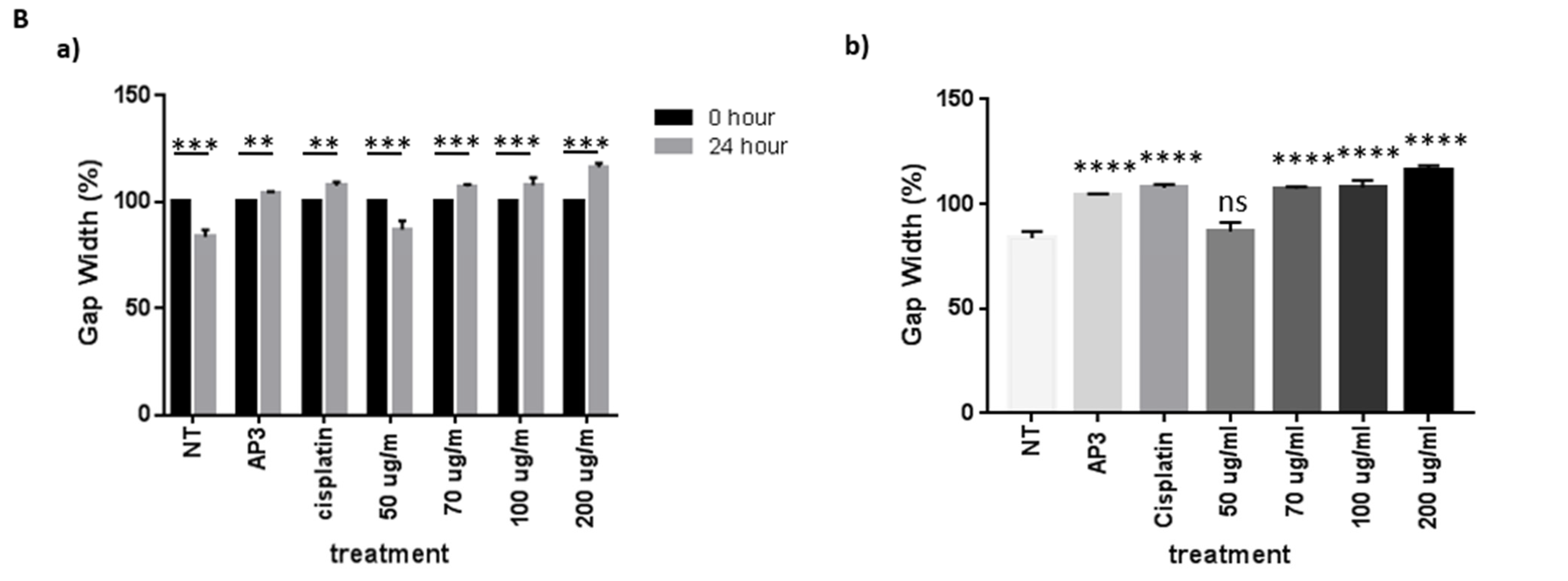

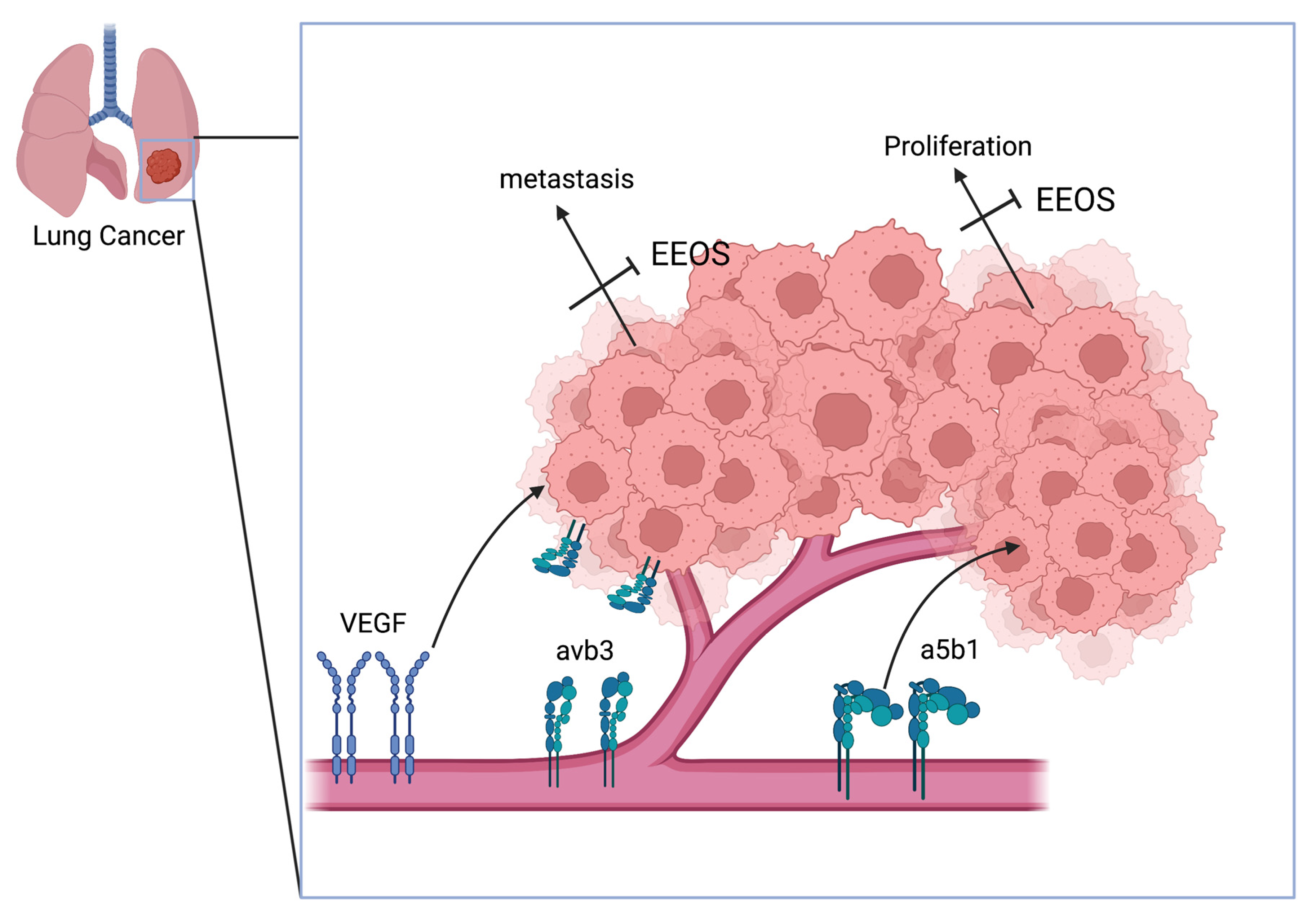
Publisher’s Note: MDPI stays neutral with regard to jurisdictional claims in published maps and institutional affiliations. |
© 2022 by the authors. Licensee MDPI, Basel, Switzerland. This article is an open access article distributed under the terms and conditions of the Creative Commons Attribution (CC BY) license (https://creativecommons.org/licenses/by/4.0/).
Share and Cite
Kustiati, U.; Ergün, S.; Karnati, S.; Nugrahaningsih, D.A.A.; Kusindarta, D.L.; Wihadmadyatami, H. Ethanolic Extract of Ocimum sanctum Linn. Inhibits Cell Migration of Human Lung Adenocarcinoma Cells (A549) by Downregulation of Integrin αvβ3, α5β1, and VEGF. Sci. Pharm. 2022, 90, 69. https://doi.org/10.3390/scipharm90040069
Kustiati U, Ergün S, Karnati S, Nugrahaningsih DAA, Kusindarta DL, Wihadmadyatami H. Ethanolic Extract of Ocimum sanctum Linn. Inhibits Cell Migration of Human Lung Adenocarcinoma Cells (A549) by Downregulation of Integrin αvβ3, α5β1, and VEGF. Scientia Pharmaceutica. 2022; 90(4):69. https://doi.org/10.3390/scipharm90040069
Chicago/Turabian StyleKustiati, Ulayatul, Suleyman Ergün, Srikanth Karnati, Dwi Aris Agung Nugrahaningsih, Dwi Liliek Kusindarta, and Hevi Wihadmadyatami. 2022. "Ethanolic Extract of Ocimum sanctum Linn. Inhibits Cell Migration of Human Lung Adenocarcinoma Cells (A549) by Downregulation of Integrin αvβ3, α5β1, and VEGF" Scientia Pharmaceutica 90, no. 4: 69. https://doi.org/10.3390/scipharm90040069
APA StyleKustiati, U., Ergün, S., Karnati, S., Nugrahaningsih, D. A. A., Kusindarta, D. L., & Wihadmadyatami, H. (2022). Ethanolic Extract of Ocimum sanctum Linn. Inhibits Cell Migration of Human Lung Adenocarcinoma Cells (A549) by Downregulation of Integrin αvβ3, α5β1, and VEGF. Scientia Pharmaceutica, 90(4), 69. https://doi.org/10.3390/scipharm90040069





